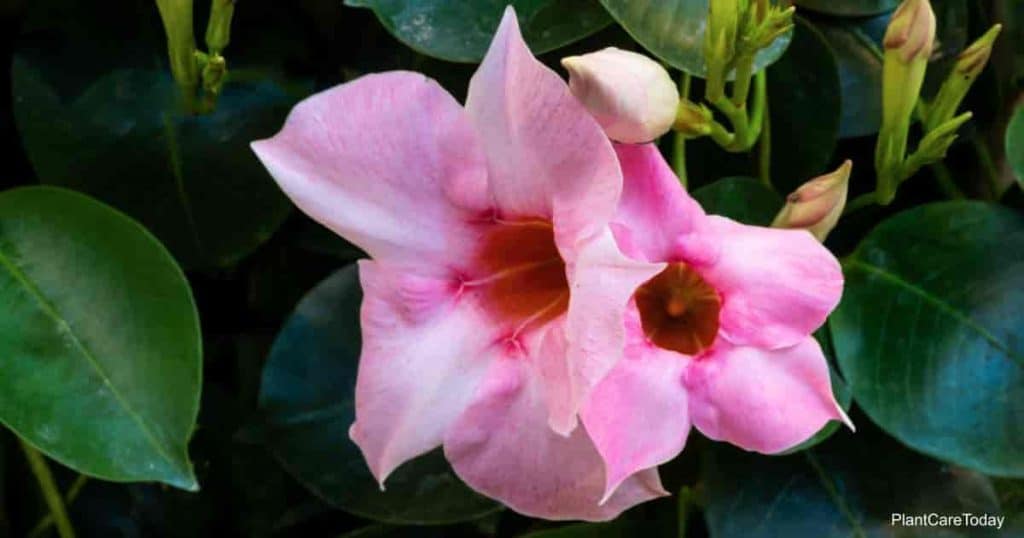Abnormal yellowing of leaves (chlorosis) is a problem common to all sorts of plants, including the Mandevilla plant.
When leaves turn yellow, they are lacking in pigment (chlorophyll).

There are several causes for this problem in Mandevilla, including:
- Nutrient Deficiency
- Poor Drainage
- Root Damage
- Root Compaction
- High pH Levels
- Pest Infestation
Follow these guidelines to determine and resolve your problem:
Nutrient Deficiency
Plants may suffer from nutrient deficiency because the soil is poor or because the soil pH level is so high that the nutrients are unavailable to the plant.
Typically, chlorosis is caused by low iron levels, but a lack of zinc, manganese, or nitrogen may also cause it.
There are several ways to determine if nutrient deficiencies cause your problem.
You can post iron deficiency by looking at the younger leaves of the plants.
Testing Soil pH Levels
You can test the pH level of the soil. Mandevilla likes a neutral pH level of about 7.0 but can tolerate pH levels ranging from 6.6 – 7.8.

Soil with a pH level higher than 6.7 causes iron to become less available to plants.
Excessive amounts of other nutrients in the soil may also cause iron to be less available to plants.
Observation
If your Mandevilla is experiencing chlorosis due to a nutrient deficiency, the progression of the yellowing gives you a clue as to what’s missing.
- If your plant lacks iron, the yellowing will begin even with lots of sunlight on younger leaves and progress to older leaves.
- The opposite is true if it is lacking in zinc, manganese, or nitrogen.
Related: Mandevilla Light Requirements – What are the light requirements to successfully grow Mandevillas?
Poor Drainage
Are you providing proper watering and drainage?
Too much or too little water may also cause chlorosis in plants, including Mandevilla. It will also result in root rot, which may also cause yellowing leaves.

Too much water saturates plant roots and prevents good nutrient absorption. Lack of water also prevents nutrients from being delivered to the plant.
This is why balanced, well-draining soil and proper watering habits are essential to prevent yellowing leaves and plant death.
Mandevilla should be kept slightly moist. Check the surface of the soil regularly. When the top inch is dry, it’s time to water.
Moreover, ensure the pot or container has drainage holes to allow excess water to drain.
Does The Mandevilla Vine Have A Disease?
Fungal diseases like leaf spot infection can cause yellow leaves on Mandevilla. Watch for small brown spots on the Mandevilla plants’ leaves.
These can quickly spread to kill the whole leaf and then the whole plant.
Plants infected with leaf spots should be quarantined and pruned thoroughly to remove all affected foliage and stems.
You can treat Mandevilla with a commercial fungicidal product designed for flowering plants. Treatment with a Neem oil solution can also be effective.
Another type of fungal infection you should keep a lookout for is powdery mildew.
Related: What do you do about caring for Mandevilla during winter?
Are Pests Feeding On Your Mandevilla?
Plants with insect infestation may also lead to Mandevilla leaves turning yellow.

Mandevilla weakened by overwatering, underwatering, or general lack of nutrients is subject to attack by insects like Mandevilla aphids or:
- Red Spider Mites
- Mealybugs
- Whiteflies
- Plant Scale Bugs
Check the undersides of the leaves for signs of these pests and their eggs.
If the infestation is advanced, you will see holes in the plant leaves where the bugs have dined and left chemical deposits that enable fungus growth.
Use the right pesticide for insect pests or a Neem oil solution to combat these pests.
Are The Mandevilla Roots Crowded?
Weak, crowded, or damaged roots may also prevent good nutrient uptake.

- If your leaf yellowing problem is caused by compromised roots, repotting or amending with a balanced, neutral, well-draining soil may help.
- When repotting, spread and prune the plant roots. Remove any dead or decaying roots. Be sure to provide ample drainage in the new pot.
- Going forward, fertilize sparingly with a water-soluble liquid fertilizer designed for use with flowering plants.
- Develop a regular watering schedule that neither drowns nor dehydrates your plant.